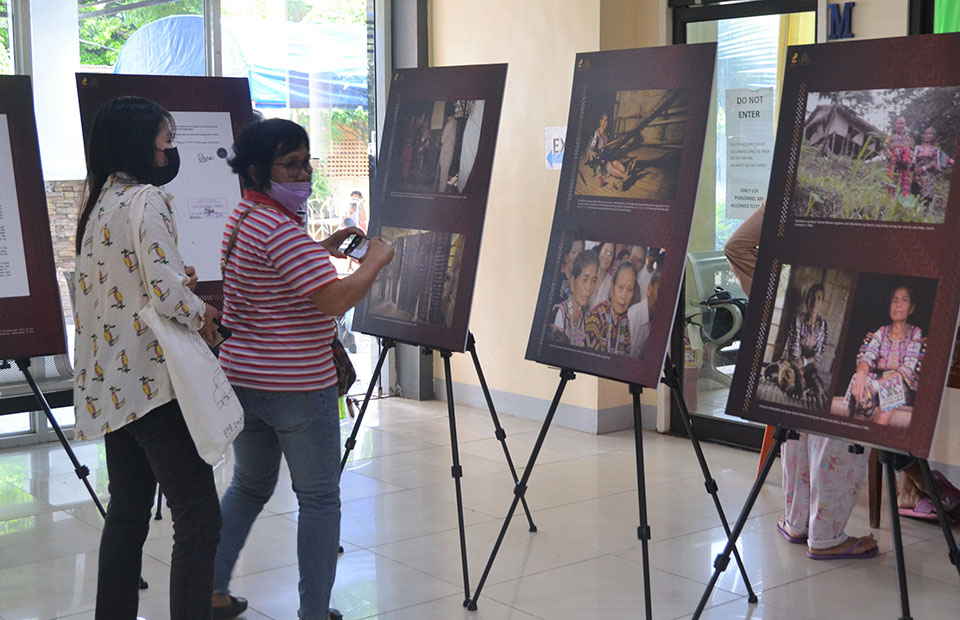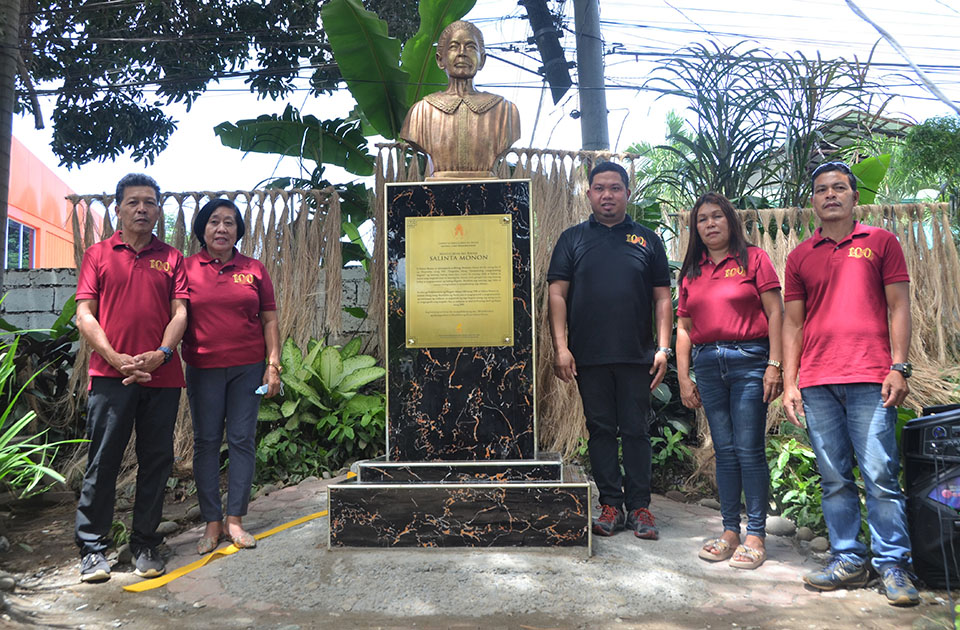Salinta Monon will go down the history of Bansalan town in Davao del Sur as “The Last Bagobo Weaver.”
As a fitting tribute to the town’s national treasure, a Birth Centennial Bust Statue and Marker of the late Monon was unveiled by the municipal government last May 16.
The unveiling was held in cooperation with the National Commission on Cultural Arts (NCAA), the same institution which named Monon as Gawad Manlilikha ng Bayan (GAMABA) in the weaving tradition in 1998.
The prestigious GAMABA award, an equivalent of the National Artist award, is given to individuals “engaged in any traditional art uniquely Filipino whose distinctive skills have reached such a high level of technical and artistic excellence.”
The award, the NCCA adds, hopes to “bring age-old customs, crafts, and ways of living to the attention and appreciation of Filipino life.”
A dyed-in-the-wool Tagabawa Bagobo, Monon was given the recognition “for fully demonstrating the creative and expressive aspects of the Bagobo abaca ikat weaving called inabal at a time when such art is threatened with extinction.”
“The quality of her work and the intricacies of her designs over a golden year as a weaver reflected the pride, beauty, and knowledge of our Tagabawa Bagobos,” said NCAA Executive Director Oscar G. Casaysay in a message that was read by his representative Carl Louie Sebastian.
“This then is a pursuing drive for our indigenous people, our cultural educators, cultural workers, and advocates to see this event as a potent driver and persuasive catalyst for a sharper Filipino development of our own culture, arts, and traditions,” he added.

According to Casaysay, the “unbreakable determination” of Monon “to live out the Bagobo tradition as one of the last weavers amongst the community has been a remarkable ground to the weight of importance to conserving, preserving, and promoting our local culture, arts, and traditions.”
Outgoing Mayor Quirina T. Sarte echoed the same sentiment. “We are very much honored that we have in our midst, from our hometown, a national artist,” she said. “Today’s generation need to know that we have such kind of personality here.”
Unfortunately, not too many people from Bansalan know her. Even after her death, no one ever heard of Monon. When she died in 2009, no one noticed of her passing.
But Malacanang has never forgotten her. So much so that President Rodrigo R. Duterte declared December 12, 2020 to December 11, 2021 as the Centennial Year of Manlilikha ng Bayan Salinta Monon.
It was through the late Councilor Lord Espina that I came to know Monon. At one time, he mentioned the last Bagobo weaver, as she was known, to me and that she was recognized by the national government as a GAMABA recipient.
Not too many people had the opportunity of meeting her personally. One deterrent is the remoteness of her barangay, Bitaug, which at that time can be reached via dirt roads that can only be traversed by so-called “skylab” vehicles (motorcycles to which wooden planks have been strapped to accommodate other passengers).
Although Bitaug is just about six kilometers away from the national highway, it would take some thirty minutes to visit her place. But once you got to the place and talked with her, it was a great honor.
Salinta was weaving when I first saw her. She was busy but when she saw us standing outside the door, she stopped and said, “Dayon mo” (the Visayan words for “Come in”). We did and my eyes wandered around the place.
She was shy and a woman of few words. She won’t say a word unless you asked her. To start our conversation, I asked her about her encounter with then American President William “Bill” Clinton (as I saw a picture frame of her picture together with him hanging in the wall).

Salinta was born on December 12, 1920 in Bitaug, a place inhabited by the Bagobos. She was still a little girl when she watched her mother weave ikat, a cloth made from abaca fibers.
Abaca looks like a banana plant. Like pili nut and narra, it is endemic in the Philippines. In the international market, it is known as Manila hemp.
At 12, Salinta asked her mother if she could teach her how to work the loom which her mother obliged. In just a matter of a few months of constant practice, she quickly excelled in the craft. “You are good,” her mother told her.
It wasn’t until Salinta was already a teenager that she developed a keen eye for traditional designs. One of her favorites was the most difficult binuwaya (crocodile). According to New York-based anthropologist Cherry Quizon, one of the first people to meet her, Salinta’s designs could be traced back to as far as 100 years.
Salinta grew up to be a beautiful lady. She caught the attention of many men but there was only one man who caught her attention: Agton Monon. Because of her weaving skills, the groom, who was a farmer, had to pay a higher bride price to Salinta’s father, Datu Bansalan Barra, so he could marry her on July 4, 1946.
The couple was blessed with five children: daughter Roda and sons Sayko, Elias, Marciano and Danilo. After her husband died in the early 1970s, Salinta tended the farm, took care of her children and continued weaving as a source of extra income.
Alexis Laura Feliciano, in an article which appeared in The Manila Times, observed: “She never thought of giving up her craft even with the dwindling number of Bagobo women interested in weaving, as only a few women have the inclination, patience or perseverance to last through the intensive training and discipline to become a full-fledged weaver.”
Abaca weaving is a laborious task. According to Salinta, it would take her three to four months to finish a fabric that measures 3.5 meters by 42 centimeters in length. One abaca tube skirt can be finished within a month. “It takes time but the result is great,” she pointed out.
The painstaking process commences with the stripping of the abaca plant to get the fiber for textile, drying the threads and tying each strand by hand. What follows next is the delicate task of setting the strands on the “bed-tying” bamboo frame. The bud or the tying of abaca fiber is what actually defines the design, she explained.
For Salinta, she was just doing what her mother and grandmothers did before her. So, when she was named as one of the GAMABA awardees, she was completely lost for words to describe her emotions. “I was totally caught by surprise when I was chosen as one of the country’s folk artists,” she said.
During the town anniversary in 2007, then Mayor Edwin Reyes bestowed on her the recognition she rightfully deserved. She was also part of the grand parade that year when a program was held in her honor.
On June 4, 2009, at the age of 88, Salinta died peacefully. “Born in ambiguity from a vanishing aboriginal tribe, she died a giant among men.” Such was the tribute of the former Mayor Reyes when he learned of Salinta’s demise.
Reyes referred to Salinta’s death as “an irreparable national loss.” It ended an era that put Bansalan on the world map. “We lost a priceless cultural treasure,” he added.
But Monon will live forever – in the hearts of those whom she touched and taught.
“Forging her heart as a mentor, a creative warrior, and a Manlilikha ng Bayan, may we also live in our hearts the purpose of her hard work and firm stand to safeguard Bagobo textile weaving,” Casaysay urged.






